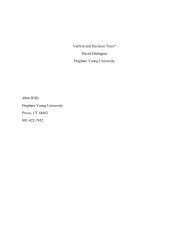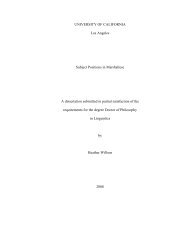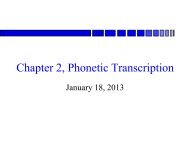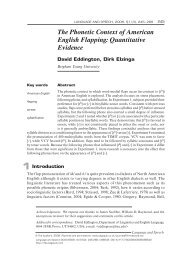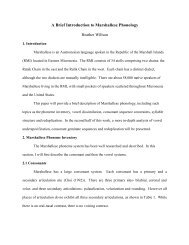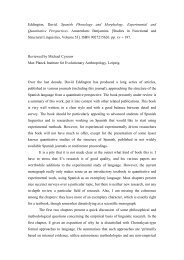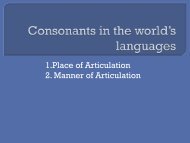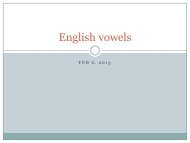Syllables and Suprasegmental Features - Department of Linguistics ...
Syllables and Suprasegmental Features - Department of Linguistics ...
Syllables and Suprasegmental Features - Department of Linguistics ...
You also want an ePaper? Increase the reach of your titles
YUMPU automatically turns print PDFs into web optimized ePapers that Google loves.
Chapter 10, day 1<br />
A P R I L 1 2 , 2 0 1 3
Quiz<br />
1. Why is it hard to define the syllable?<br />
2. How can we prove that syllables exist?<br />
3. What is ambisyllabicity?<br />
4. Do languages tend to like to put consonants in the<br />
onset or in the coda?<br />
5. What is the most common syllable shape across the<br />
languages <strong>of</strong> the world (choose one): CVC, CCV, V,<br />
CV, CCCVCCC
If you want to turn in a draft <strong>of</strong> your final paper for<br />
review, it must be turned in by 5 on Monday.<br />
Same with extra credit.<br />
Everything needs to be turned in by 5 on Monday.<br />
No exceptions.
Outline <strong>of</strong> Chapter 10: Examining<br />
<strong>Suprasegmental</strong>s across languages<br />
1. <strong>Syllables</strong><br />
2. Length<br />
3. Timing (intonation)<br />
4. Pitch<br />
5. Stress
Top 10 questions about syllables you can’t<br />
live without knowing the answer to:<br />
1. What are the parts <strong>of</strong> the syllable?<br />
2. How do we know syllables exist?<br />
3. What makes defining a syllable so hard?<br />
4. What does the word “ambisyllabic” mean?<br />
5. What is the sonority principle?<br />
6. Why do we change the number <strong>of</strong> syllables in a word in casual<br />
speech?<br />
7. What can be a nucleus in a language?<br />
8. How do syllables differ?<br />
9. How do languages differ in the number <strong>and</strong> type <strong>of</strong> syllables?<br />
10. How do dialects differ in their use <strong>of</strong> syllables?
5. What is the sonority principle?<br />
Which sounds are sonorant?
What Sounds are onsets, codas <strong>and</strong> nuclei?
4.5<br />
4<br />
3.5<br />
3<br />
2.5<br />
2<br />
1.5<br />
1<br />
0.5<br />
0<br />
Sonority Hierarchy<br />
[sli:p]<br />
s l i: p<br />
Sonority
4.5<br />
4<br />
3.5<br />
3<br />
2.5<br />
2<br />
1.5<br />
1<br />
0.5<br />
0<br />
Sonority Hierarchy<br />
*[lsi:p]<br />
l s i: p<br />
Sonority
pickle<br />
Sudden<br />
spasm<br />
fire<br />
Practice with some other words
5. What is the sonority principle?<br />
Words in different languages:<br />
Grizzanese:<br />
dman.de do.brze<br />
bzo war.sza.wa<br />
dge.va<br />
are they violating the sonority principle?<br />
What about spaghetti?
Sonority Sequencing Principle<br />
(SSP):<br />
•<strong>Syllables</strong> attempt to provide maximal separation<br />
across the sonority scale (at least 2 degrees <strong>of</strong><br />
separation)<br />
Black<br />
CV syllables provide the maximal separation within<br />
<strong>and</strong> across syllables.<br />
• Can you think <strong>of</strong> any English examples where<br />
this principle might not work?
SSP<br />
Examples from languages:<br />
Plateaus: English apt, Russian kto, mohawk<br />
kka:wes,<br />
Reversals: English ax, German obst, russian lba,<br />
No peak: English yearn
5. Sonority hierarchy<br />
Leong (2008) found that children had faster reaction<br />
times to sounds that were higher on the sonority<br />
hierarchy <strong>and</strong> also learned to read <strong>and</strong> write these<br />
words faster.
6. Why do we sometimes change the number <strong>of</strong><br />
syllables?<br />
We mainly do it in fast speech or on syllables that are<br />
not keeping the CV rule or are violating the sonority<br />
principle:<br />
Did you eat yet jit yet?<br />
Athlete athalete<br />
Spaghetti psigetti<br />
We almost always delete in such a way that we have CV<br />
syllables:<br />
Batteries battries
7. What can be a nucleus in a language?<br />
Languages differ in what can constitute a nucleus.<br />
Ex: Tashlhiyt Berber<br />
Words in Berber<br />
/tft. kt. stt/ ‘you sprained it’<br />
/tl. di/ ‘she pulls’<br />
/ts. krt/ ‘you did’<br />
/tn. Sft/ “you grazed the skin<br />
/tx. znt/ ‘you stored’<br />
ttggwa<br />
ttsxxan<br />
http://www.phon.ox.ac.uk/jcoleman/ttggwa.wav<br />
http://en.wikipedia.org/wiki/Berber_languages
7. What can be a nucleus in a language?<br />
Nuxálk:<br />
[pʰs] 'shape, mold'<br />
[pʼs] 'bend'<br />
[pʼχʷɬtʰ] 'bunchberry'<br />
[t͡sʰkʰtʰskʷʰt͡sʰ] 'he arrived'<br />
[tʰt͡sʰ] 'little boy'<br />
[skʷʰpʰ] 'saliva'<br />
[spʰs] 'northeast wind'<br />
[tɬʼpʰ] 'cut with scissors'<br />
st͡sʼqʰ] 'animal fat'<br />
[st͡sʼqʰt͡sʰtʰx] 'that's my<br />
animal fat over there'<br />
[sxs] 'seal fat'<br />
[tʰɬ] 'strong'<br />
[qʼtʰ] 'go to shore'<br />
[qʷʰtʰ] 'crooked'<br />
[kʼxɬɬtʰsxʷ sɬχʷtʰɬɬtʰs<br />
(t͡s?)] 'you had seen that I<br />
had gone through a<br />
passage'
8. How do syllables differ?<br />
Light syllables: V , CV, CVC, CCVC, CCCV<br />
Heavy syllables: CV: , CVN(L), CVCC, CVCCC, CVVCC (sometimes<br />
CVC)<br />
How do we decide if a syllable is heavy or light?<br />
Depends on moras<br />
Mora: unit <strong>of</strong> weight in a language (how long the syllable is)<br />
What part <strong>of</strong> the syllable determines the weight <strong>of</strong> the syllable?<br />
the coda (<strong>and</strong> sometimes the nucleus)<br />
Light syllables contain 1 mora<br />
Heavy syllables contain 2 moras<br />
Super heavy might contain 3 moras
Different syllables in words<br />
V = a<br />
VC = <strong>of</strong><br />
CV = so<br />
CVC = bad<br />
CCVC = slit<br />
CCVCC = slicked<br />
<strong>Syllables</strong><br />
Moras play a pr<strong>of</strong>ound role in things like poetry <strong>and</strong> rhythm<br />
<strong>of</strong> a language—our stressed syllables tend to be heavy <strong>and</strong><br />
superheavy<br />
For this reason, <strong>of</strong>ten poetry is used in language<br />
reconstruction
8. How do syllables differ?<br />
Languages differ in what kinds <strong>of</strong> syllables they allow:<br />
Out <strong>of</strong> 200 languages (Fudge <strong>and</strong> Shockey, 1998)<br />
Onsets:<br />
V—0% must have initial V<br />
CV –69% must have onset C<br />
CCVC—45% allow CC onsets<br />
CCCVCCC –15% allow CCC onsets<br />
Codas:<br />
CV—12% cannot have final C<br />
CVC—8% must have coda C<br />
CCVCC—9% allow CC codas<br />
CCCVVCCC—4% allow CCC codas
Typical syllable types across languages<br />
http://wals.info/feature/12A?tg_format=map&v1=cfff&v<br />
2=cf6f&v3=cd00<br />
http://wals.info/chapter/12<br />
Across the set <strong>of</strong> 484 languages for which both consonant<br />
inventory size <strong>and</strong> syllable structure data are included:<br />
languages with simple canonical syllable structure have<br />
an average <strong>of</strong> 19.1 consonants<br />
languages with moderately complex syllable structure<br />
have an average <strong>of</strong> 22.0 consonants<br />
languages with complex syllable structures have an<br />
average <strong>of</strong> 25.8 consonants.
9. How do languages differ in the<br />
number <strong>and</strong> type <strong>of</strong> syllables?<br />
Number <strong>of</strong> possible syllables:<br />
range 150 - 200,000<br />
Depends on<br />
1. Number <strong>of</strong> Consonants<br />
2. Number <strong>of</strong> Vowels<br />
3. Number <strong>of</strong> possible syllable structures<br />
CV, (C)V, CV(C), (C)CV, etc.<br />
4. Number <strong>of</strong> tone contrasts<br />
Which language has the largest number <strong>of</strong> possible syllables?
Principles that guide syllable types<br />
The most prevailing principle is: We like simple CV<br />
syllables <strong>and</strong> want to use them <strong>and</strong> have them as<br />
much as possible.<br />
Children acquire simpler syllable types before the<br />
more complex ones.<br />
All languages have CV syllables <strong>and</strong> they are the<br />
most prevalent<br />
Syllable-related historical change tends to go in the<br />
direction <strong>of</strong> greater syllable simplicity.<br />
We remember <strong>and</strong> can learn words better when<br />
they have simple CV syllables <strong>and</strong> sounds we can<br />
pronounce (Ellis et al., 1999)
Spanish <strong>Syllables</strong> <strong>and</strong> Dialects





